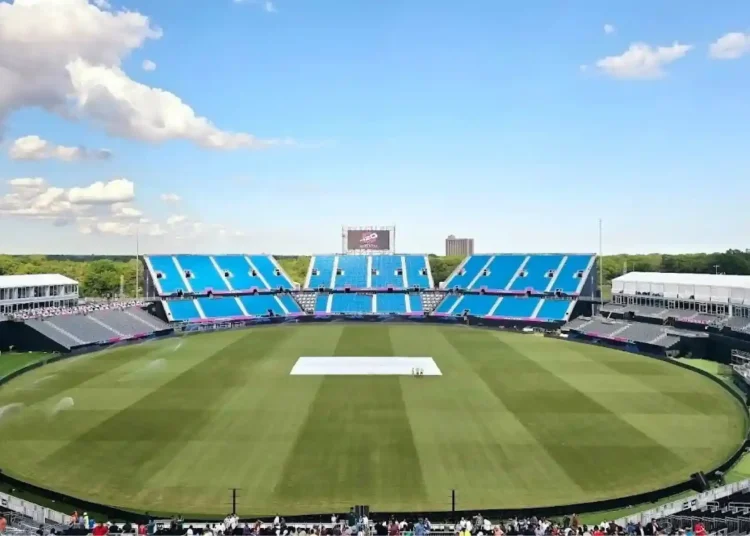What were the Weather Conditions at Nassau County Stadium?

Cricket matches at Nassau County Stadium thrive under specific weather conditions, each playing a crucial role in ensuring player performance and spectator comfort. The ideal climate for cricket involves a delicate balance of temperature, humidity, rainfall, wind, and cloud cover, all carefully monitored to provide the best possible environment for the game.
Temperature
The sweet spot for temperature during cricket matches is between 22°C and 25°C (72°F to 77°F). This range ensures that players are energetic and spectators are comfortable, avoiding the extremes that can lead to heat exhaustion or cold discomfort.
Humidity
Moderate humidity levels, around 50% to 60%, are crucial. This range helps in maintaining a balance where the air is neither too dry, which can affect the throat and breathing of the players, nor too damp, which might impact the handling of the cricket ball and overall player performance.
Rainfall
Cricket is best played under dry conditions. Therefore, a low rain probability, ideally below 20%, is preferred to minimize game interruptions and maintain a consistent playfield. Sudden showers can pause play and alter the pitch conditions unpredictably.
Wind Conditions
Light to moderate winds, about 10-15 km/h, are ideal. While a gentle breeze can keep the atmosphere fresh and aid slight swing bowling, strong winds can distort the ball’s trajectory, posing challenges to both bowlers and batsmen.
Cloud Cover
Partly cloudy to sunny skies are optimal for cricket at Nassau County Stadium. Clear skies enhance visibility for players and create a pleasant ambience for the audience, whereas too much cloudiness can lead to cooler temperatures and unexpected rain.
In summary, the best weather for a cricket match at Nassau County Stadium would feature mild temperatures, moderate humidity, low chances of rain, light winds, and clear skies.
The pitch behaviour at Nassau County Stadium can vary significantly with weather conditions, influencing how the game unfolds. Here’s a detailed overview:
| Weather Condition | Pitch Behavior | Preparation Strategy |
|---|---|---|
| Clear and Sunny | It dries out, is favourable for batsmen, has a good bounce and pace, and has a reduced swing for bowlers. | Ensure consistent surface maintenance to manage quick drying and maintain bounce. |
| Overcast and Humid | Increases assistance for bowlers, can retain moisture, aids seam movement, and slows outfield. | Monitor humidity and moisture levels closely, and prepare for increased swing and seam movement. |
| Rainy | Wet pitch assists bowlers more than batters, can be unplayable, and affects ball grip. | Ensure efficient drainage to handle rain, and prepare pitches to handle moisture without becoming unplayable. |
| Dew (Night Matches) | Dew makes the ball slippery, difficult to grip for bowlers, and easier to bat in the second innings. | Implement dew management strategies, such as using covers or chemical treatments to reduce dew impact. |
The Interplay of Tahoma 31 Bermuda Grass and Weather at Nassau County Stadium
Tahoma 31 Bermuda grass, selected explicitly for Nassau County Stadium, played a crucial role in adapting to the local climate, ensuring that the drop in pitch maintained optimal conditions regardless of weather variations. This grass type is known for its resilience and adaptability, which is essential in a region like New York, where weather conditions can vary dramatically across seasons.
The unique characteristics of Tahoma 31 Bermuda grass, including its drought resistance and lower nitrogen needs, make it particularly well-suited for maintaining a high-quality pitch under varying weather conditions. Its ability to thrive with less water benefits the stadium, especially during dry, hot summers, ensuring the grass remains green and playable without excessive watering.
Moreover, its adaptability to different mowing heights allows groundskeepers to adjust the grass quickly to weather changes, ensuring the surface remains consistent for play.
During the cooler, humid days, Tahoma 31’s robust root system helps it utilize the available moisture efficiently, preventing the pitch from becoming too soft and slowing down the game. Conversely, in the warmer months, the grass’s heat tolerance ensures that it does not lose vitality and continues to provide a firm, fast surface conducive to high-scoring cricket games.
Tahoma 31 Bermuda Grass: Enhancing Cricket Pitch Resilience
Tahoma 31 Bermuda grass significantly impacts the behaviour of cricket pitches at Nassau County Stadium by enhancing resilience against the local weather’s challenges. Its engineered traits allow it to withstand and adapt to the diverse conditions experienced in New York, from humid summers to cooler, wetter autumns.
This adaptability preserves the pitch’s quality across seasons. It minimizes the maintenance burden, ensuring that the playing surface remains consistent and predictable, which is crucial for fair play and athlete performance. This grass type exemplifies how advanced turf management can symbiotically work with local climatic conditions to maintain a world-class sports venue.
The Influence of Temperature and Humidity on Performance
 At Nassau County Stadium, temperature and humidity levels significantly influenced cricket matches. Ideal playing conditions hover around 22°C to 25°C (72°F to 77°F), providing comfort and preventing players from overheating. However, when temperatures exceeded this range, players faced challenges like heat stress, which could lead to reduced stamina and concentration.
At Nassau County Stadium, temperature and humidity levels significantly influenced cricket matches. Ideal playing conditions hover around 22°C to 25°C (72°F to 77°F), providing comfort and preventing players from overheating. However, when temperatures exceeded this range, players faced challenges like heat stress, which could lead to reduced stamina and concentration.
High humidity levels compounded these effects, making it difficult for players to maintain peak performance throughout the game. Conversely, cooler temperatures below 15°C (59°F) led to muscle stiffness and reduced mobility, potentially increasing the risk of injuries during play. The stadium’s open design did little to shield players from these elements, making weather adaptability a crucial aspect of game strategy.
📚 Curious about other top cricket stadiums? Visit our detailed profile of the Nassau County International Cricket Stadium for a look at its architectural marvels and famous matches.
Impact of Rain and Wind on Game Tactics
Rain and wind were pivotal in shaping game strategies at Nassau County Stadium. Light rains could dampen the pitch, aiding bowlers with increased ball swing and seam movement, while heavy rainfall might disrupt play or alter the pitch’s behavior unpredictably.
Wind affected the ball’s trajectory, challenging both bowlers and batsmen to adjust their techniques. For instance, strong gusts could divert a well-aimed ball, complicating batting and bowling strategies and forcing teams to adapt to the prevailing conditions.
The Challenge of Sudden Weather Changes
Sudden weather changes were common at Nassau County Stadium, presenting unique challenges. A clear day could quickly turn overcast, dramatically altering the playing conditions. Such shifts could advantage bowlers over batsmen, notably if humidity levels rose or the wind intensity changed.
Teams had to be prepared for these rapid transformations by having flexible strategies and players ready to adapt to varying conditions. The ability to quickly adjust to weather changes often determines the outcome of matches, highlighting the importance of weather forecasting and strategic planning.
Was There a Dew Factor in Evening Matches?
Evening matches at Nassau County Stadium often contended with the dew factor, which could significantly impact the latter stages of a game. Dew made the outfield grass slippery, affecting fielding precision and the ball’s movement. Bowlers struggled to grip the ball, and spinners found extracting turn from a wet surface particularly challenging.
This condition favoured batsmen, who could play shots more confidently, knowing the ball would skid onto the bat faster. Teams often chose to field first in evening games to avoid the complications Dew posed during the match’s critical phases.
Conclusion
Weather at Nassau County Stadium was a formidable opponent in its own right, impacting every facet of cricket played there. From altering pitch conditions to affecting players’ physical performances, the elements played a critical role in defining the strategies and outcomes of matches. Understanding and adapting to these conditions was essential for teams aspiring to excel.
🎉 Wrap up your cricket stadium tour by exploring our in-depth analysis of Nassau County International Cricket Stadium. Learn about the events that shaped its legendary status in the world of sports.
Therefore, the legacy of Nassau County Stadium is not just about architectural innovation but also about the lessons learned in playing under diverse and challenging weather conditions, providing valuable insights for future tournaments hosted in similar venues.






